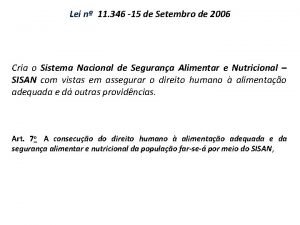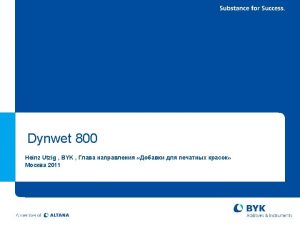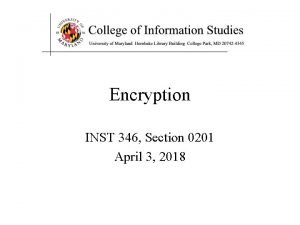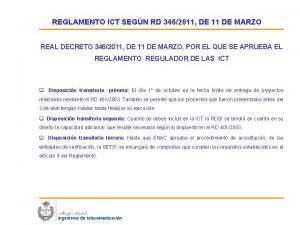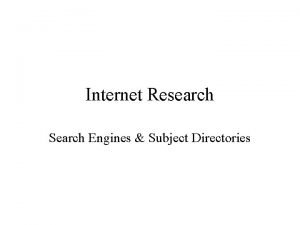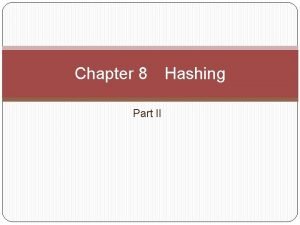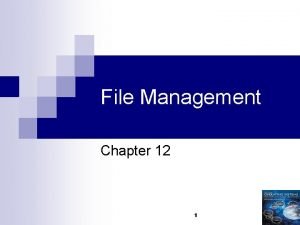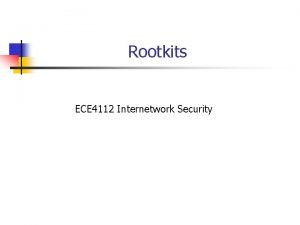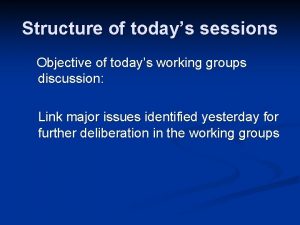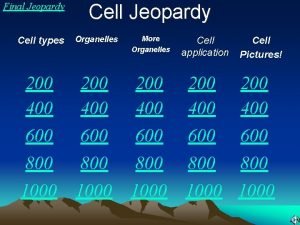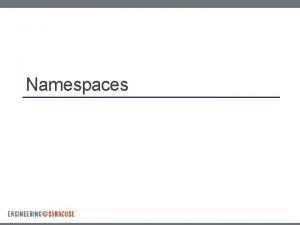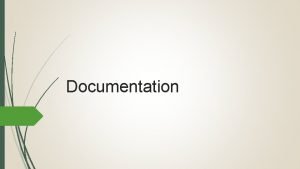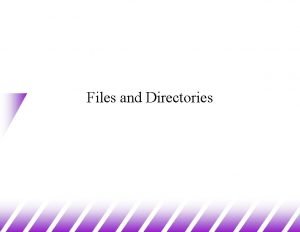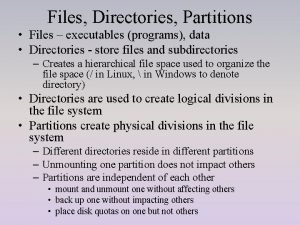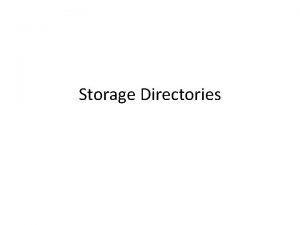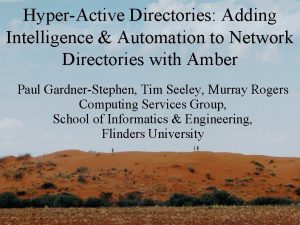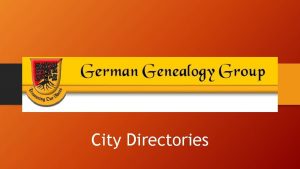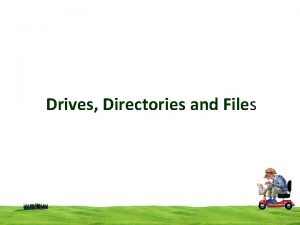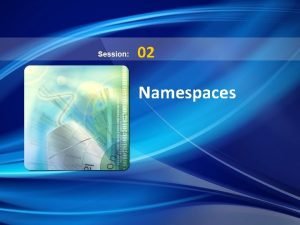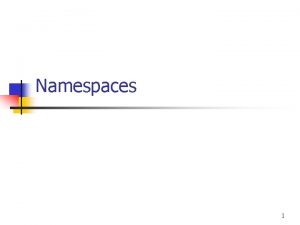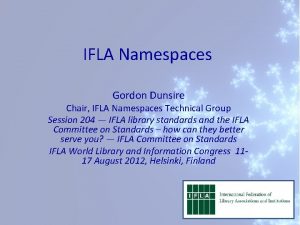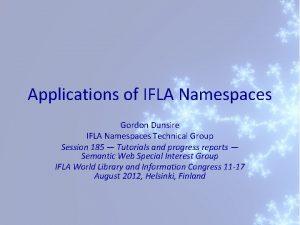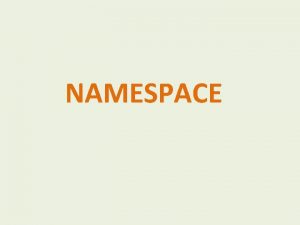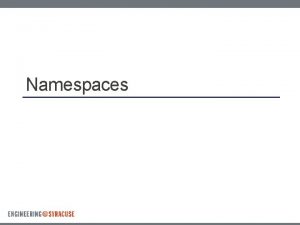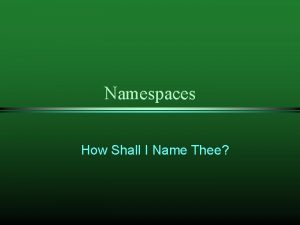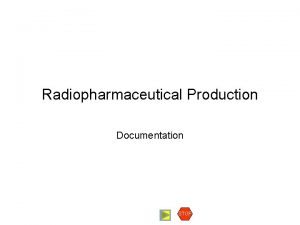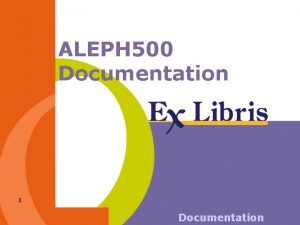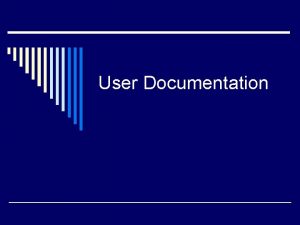IST 346 Namespaces Directories Documentation Todays Agenda Namespaces



























- Slides: 27

IST 346: � Namespaces � Directories � Documentation

Today’s Agenda � Namespaces – what is a namespace? Why is it important? � Examples of namespace policies � Directories and Directory services � LDAP – lightweight directory access protocol � Active Directory

Namespaces

So, what is a namespace? �A 1. 2. namespace consists of : A set of defined and named keys The attributes associated with each of the keys �For example, the linux and windows user accounts we’ve created in our labs are namespaces 1. 2. The have defined names (the user accounts themselves) tom, dick, harry, etc… Each account has attributes associated with it: password, home directory, default shell, etc…

All sorts of namespaces: Compute r Names Email addresse s Printers User Accounts Service Names IP Addresse s

Two type of namespaces � Flat � No duplicates can exist in a flat namespace. � SU Net. ID is a flat namespace: no two people have the named key: mafudge, sjrieks, mrwunder � User accounts are a flat namespace. � Hierarchical � Namespace is organized in a tree � Duplicates can exist at nodes in the tree, but the overall name is globally unique. � DNS is an example of such a namespace: www. syr. edu www. microsoft. com help@oracle. com help@microsoft. com

Namespace Policy � Consistent namespaces make everyone’s job easier. � Helps your users and admins find resources � A well-governed policy is the key to a consistent and reliable namespace. � The policy should have collision prevention for flat namespaces. � Once you decide on a naming convention, it is difficult to change it. � If there’s one thing you should do by committee, its namespace policy creation! � IST-Printer-H 010 -DELL 5310 C

Issues Surrounding Namespaces • Does the namespace contain sensitive data? • How does one formulate the named keys? • How long should entries remain? When should they be removed? Protection Longevity Naming Conventio n Scope • Where should they be used?

Naming Conventions � Formulaic Based on an algorithm, generic look and feel � Student 001, student 1002, server 0001 � � Themeatic Planets, Constellations, Cartoon charaters � Gamera. syr. edu, rodan. syr. edu � � Functional Name matches function � smtp-host. syr. edu, help. syr. edu, clock. syr. edu � � Descriptive By location, resource, type, device class � How SU names its objects in Active Directory. � � No Method Everyone picks their own, first come first serve. � This is how DNS registrars allocate names on the Internet. � � Applied uses are usually a combination of multiple approaches.

Some Examples of namespaces. And their naming conventions

Example namespace: Net. ID � What � is it? Represents accounts for all users on campus � Rules and Constraints: Legacy systems require the account to be no more than 8 characters. � Flat namespace for all users associated with SU. � No two people can have the same Net. ID � � Convention: � Named keys are created via a combination of formulaic and functional approaches � Examples: Michael A Fudge - mafudge � Peggy M Brown – pmbro 01 �

i. School Workstation Naming (AD) � What � The � Rules is it? method the i. School uses to identify user workstations and Constraints � For legacy windows computers, 15 characters maximum � Must begin with IST- to avoid conflicts with other organizations on campus (flat namespace) � Convention: � Named keys are created from the user’s netid and machine type (fac/staff desktop/laptop) � Examples: � IST-SD-MAFUDGE � IST-FL-DJMOLTA

DNS Namespace � What is it? � Used for registering names of computers on the internet. � www. syr. edu help@google. com � Rules and Constrains � Except for. edu, . gov and. mil there aren’t any � DNS is a heirarchy, duplicates allowed within different contexts, but not globally. � www. syr. edu www. syracuse. com www. google. com � Convention � Top level, org level, hostname � Top level: http: //www. iana. org/gtld. htm

DNS Hierarchy www. syr. edu www • host Syr • domain Edu • gtld

Descriptive Namespaces � Descriptive names are the friendliest namespace. � They are usually “self-explanatory” � The should be governed carefully within the organization, for obvious reasons. � Examples: � president@whitehouse. gov forwards email to user barak. obama � chanellor@syr. edu forwards email to user ncantor � http: //printing. google. com gives you information about all the printers in google � The wireless networks Air. Orange. Help, Air. Orange. X

Managing Namespaces � Let’s suppose your organization has � 10 Linux, 10 windows servers, and 100’s of workstations. � 100’s of Users � An established a naming convention for user accounts and computers. � How can you: � Avoid collisions of named keys? � E. g. mafudge = Mary Alice Fudge on a Linux host, Michael A Fudge on a Windows host. � Manage the user and computer namespaces so that your system admins follow the conventions? � Create � These user fudgema, instead of mafudge for example. are real-world issues… ideas?

Meta-Directory �A Meta-Directory is a unified database of your namespaces. � To create a named key for a namespace, such as a new user: � The information is added to the meta-directory � The account is provisioned from the meta-directory to the resource itself. (Account created on the Windows or Linux Server or both) � Meta-Directories � You are namespace management. can buy identity management software to implement a meta-directory or build your own. � These solutions require a lot of planning, design and testing.

Directories offer a database for your namespaces.

Directories 101 � Directory �A collection of information that is primarily searched and read, but rarely modified. � Named keys from namespaces are ideal storage candidates for directories. � Directory � Provides � Directory Service access to directory information. Server � Application that provides a directory service. � Note: � Directories are not Meta-directories. Directories store named keys, but do not provision them.

Advantages of Directories �Make administration easier. �Change data only once: people, accounts, hosts. �Unify access to network resources. �Single sign on. �Single place for users to search (address book) �Improve data management consistency (one location vs many) �Secure data through only one server.

LDAP �Lightweight Directory Access Protocol � Lightweight version of the DAP based on X. 500 directories. http: //www. x 500 standard. com/ � Just an Access protocol, not a directory itself. � The directory must be implemented on the server end. �Directory services which implement LDAP � Open. LDAP � Fedora Directory Server (formerly Sun, Netscape) � Mac Open Directory � Microsoft Active Directory � Novell e. Directory (NDS)

LDAP Structure � Hierarchal structure � Containers � An are called organizational units LDAP directory is made of entries. � Entries � Each may be employee records, hosts, accounts etc. entry consists of attributes. � Attributes can be names, phone numbers, etc. � object. Class attribute identifies entry type, or schema � Schema determines the available attributes for the entry � Each attribute is a type / value pair. � Type is a label for the information stored (name) � Value is value for the attribute in this entry. � Attributes can be multi-valued.

LDAP DN � The DN, or distinguished name represents the path from the root of the directory to the entry. � (In this example the rectangle is a user object. Class, and the trapezoid is a computer object. Class) dc=syr, dc=edu ou=IST cn=maufgde ou=WHIT cn=ist-sdmafudge cn=jadaley Dn: cn=mafudge, ou=IST, dc=syr, dc=edu my account Dn: cn=ist-s-mafudge, ou=IST, dc=syr, dc=edu my computer

LDAP Authentication �Anonymous �Binds �Simple �Use Authentication with empty DN and password. Authentication with DN and password. Cleartext. Bad. Authentication over SSL/TLS SSL to encrypt simple authentication. �Simple �SASL Authentication and Security Layer is an extensible security scheme. �SASL mechanisms: Kerberos, GSSAPI, SKEY

Active Directory � Microsoft’s Directory service � Used to manage users and computers in the enterprise. � Hierarchy: Forest, Trees, Domains � The Namespace is flat at the domain level � AD Implemented using LDAP + DNS + Kerberos � LDAP used for user, group, computer, policies and more. � Kerberos used for computers on the domain and user logons � DNS is used for naming computers on the domain

Active Directory and LDAP demos

Questions?
 Ist 346
Ist 346 Todays agenda
Todays agenda Round off 241
Round off 241 Stats-346
Stats-346 Lei 11 346
Lei 11 346 Ley 14 346
Ley 14 346 Byk-345
Byk-345 427 266 to the nearest ten thousand
427 266 to the nearest ten thousand Cipher of 346
Cipher of 346 Accessory nerve (xi)
Accessory nerve (xi) Ict reglamento
Ict reglamento What is subject directory
What is subject directory Hashing
Hashing Directories pricing tables schedules and name list
Directories pricing tables schedules and name list Makefile multiple source files
Makefile multiple source files Knark hides or unhides files or directories. it ?
Knark hides or unhides files or directories. it ? Agenda sistemica y agenda institucional
Agenda sistemica y agenda institucional Ich habe heute klassendienst
Ich habe heute klassendienst Es ist herbst bunte blätter fliegen
Es ist herbst bunte blätter fliegen Winter kommt winter kommt flocken fallen nieder lied
Winter kommt winter kommt flocken fallen nieder lied Zu glauben ist schwer. nichts zu glauben ist unmöglich
Zu glauben ist schwer. nichts zu glauben ist unmöglich Es war eine mutter
Es war eine mutter Todays science
Todays science Rprefer
Rprefer Todays objective
Todays objective Todays objective
Todays objective Cells jeopardy 7th grade
Cells jeopardy 7th grade Midlands 2 west (north)
Midlands 2 west (north)




